KC artist helps Black women learn to love and flaunt their natural curls, coils
Editor’s Note: This interview is part of the second season of Voices of Kansas City, a project created in collaboration with KKFI Community Radio to highlight the experiences of Kansas Citians making an impact on the community. All the episodes are available at the KKFI.org site https://kkfi.org/program/voices-of-kansas-city/ and listen to KKFI live on 90.1 FM, or at KKFI.org. Do you know someone who should be featured in a future season of Voices of Kansas City? Tell us about them using this form.
Coming from a multi-cultural home, Christa Rice learned early on that her hair was different and set her apart. Seeing her thick curly hair as something undesirable and taboo she, like many Black woman, tried to tame it and fit into the old American beauty mold of straight and manageable.
It was not until years later that Rice took a journey of acceptance with her natural hair and she found an entire community of women of color going through the same struggles. Rice did her part to build a community here around natural hair when she started KC Curly, a photo shoot that brings hundreds of women together in a celebration of their natural coiling, curly and wavy hair.
Rice uses her platform as a hair activist to raise awareness toward issues of Black hair and uses Black hair as a muse for her art work, depicting texturized pieces that feature Black hair and is on display at the new Zhou B Art Center in the Historic 18th and Vine District.
The Star invited Rice, known on social media as Crissi Curly, to join us in the studios of KKFI radio where she recently spoke to J.M. Banks, The Star’s culture and identity reporter. That interview, with minor editing for space and clarity, is published here in a question and answer format to share Foster’s authentic voice.
Meet Christa Rice
The Star: Why don’t you begin by telling us a little bit about your background and upbringing here in Kansas City.
Well, I’m a Kansas City native. Born and raised Kansas City. I am a social worker, I am an artist, also just a entrepreneur. This is who I am in a nutshell.
So how did you end up getting into hair and art activism?
So when I was younger, I knew that there was challenges when it comes to our hair. But I’ve always been passionate about just hair in general and just what it looks like, how it makes you feel when you get your hair done. And so, I think, for me it all started just kind of at a young age being very interested in just hair and as a artists.
My family, they’re all artists, so just growing up just being very creative, art, hair, my mom played the piano, everybody was pretty creative.
At what age did you start to realize that your hair was kind of different from everybody else’s?
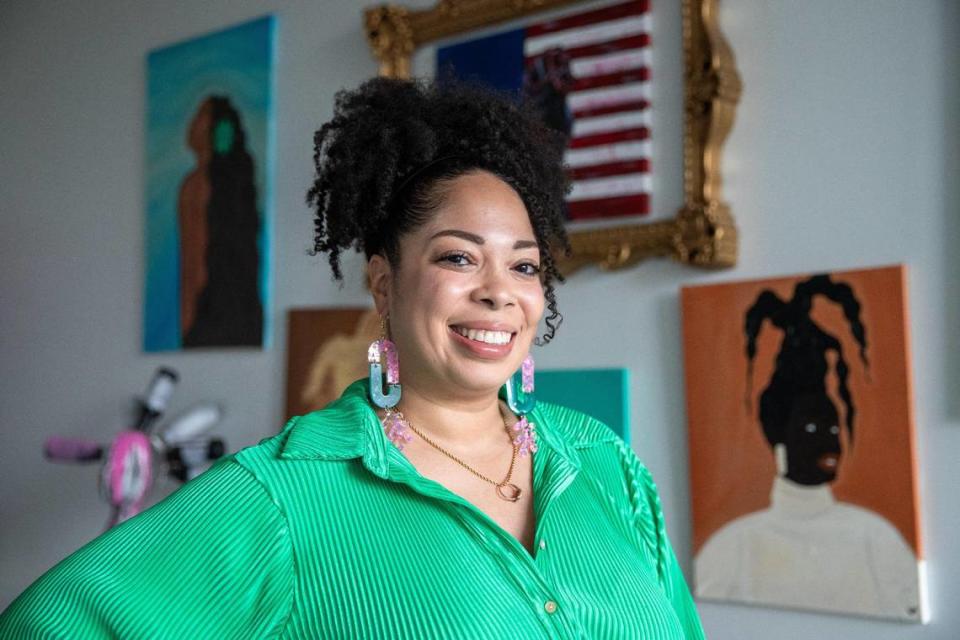
Pretty young. Also, we would, you know, go through little things like people saying your hair is so thick. But it wasn’t a positive thing. There’s this story, and maybe I was like six or seven, but my grandmother she brought us to this beauty salon for the first time ever. It’s the first time I ever went into a beauty salon and we got our hair done.
I did notice that they were doing our hair a little bit different, but it was beautiful when it was done. But when we got home, my mom was really upset because they didn’t comb our hair all the way through. So basically our hair was like very matted. So I was like, what’s going on? I don’t get what’s going on? But they kept saying at the beauty salon, “your hair so big, and I don’t get what’s going on.”
Also, just seeing the standard, you know, growing up of having straight hair and the beauty behind it and that was just a muse. I want to be beautiful, I want my hair to be straight.
So you grew up with this negative connotation around having thicker hair. And how was that, growing up with that kind of misconception about your natural hair?
I didn’t know anybody else struggled with anything at all. You know, you’re just a kid. But when I wanted to get a perm at the time, and in every household it’s what age can you get the perm? So my sister got one in her freshman year. So it was freshman year, that’s when I could get mine.
And so I just had this very negative conversation about myself. It was mainly like my self love for myself, and so that’s when I say it’s about hair, but then it’s also about that self esteem as a child. Like we shouldn’t have to be worrying about our hair or anything like that.
And so I just feel that it just kind of grew from there and I just couldn’t wait to get a relaxer so I can be pretty. So that was my thought process behind being pretty.
So when did you begin to start to embrace your natural hair and go through your journey?
I started the thought process with I think I need to stop putting relaxer in my hair, because I don’t think I was taking care of it the way I need to. Now, I’m not saying relaxers are bad or anything like that. I believe that, you know, get whatever you want to get for your hair as long as it’s healthy.
But my hair was breaking off tremendously. I was like, man, when I was little, I had so much hair. I think it’s time for me to make a change and that was back in 2010 or 2009. So, when I start transitioning, I wasn’t really telling everybody or anything like that, but I kind of stopped getting relaxers.
And so, you know, people were asked what are you doing with your hair? So I was starting to get sew ins and put weave in my hair to cover up the transition. So I cut my hair off, I want to say 2011 and then it was all of a sudden the comments, “what are you doing?” Or “Why are you doing that to your hair?” “How come you’re doing that?” I’m like, this relaxer is not working with my hair anymore, so I just need a fresh start, basically.
I was dating someone at the time and they were “what are you doing with your hair? What’s going on?” And just the negative connotations that came behind it. And there is a point in time in my life where I feel like, you know what, God made my hair like this for a reason. It’s time for me to embrace it.
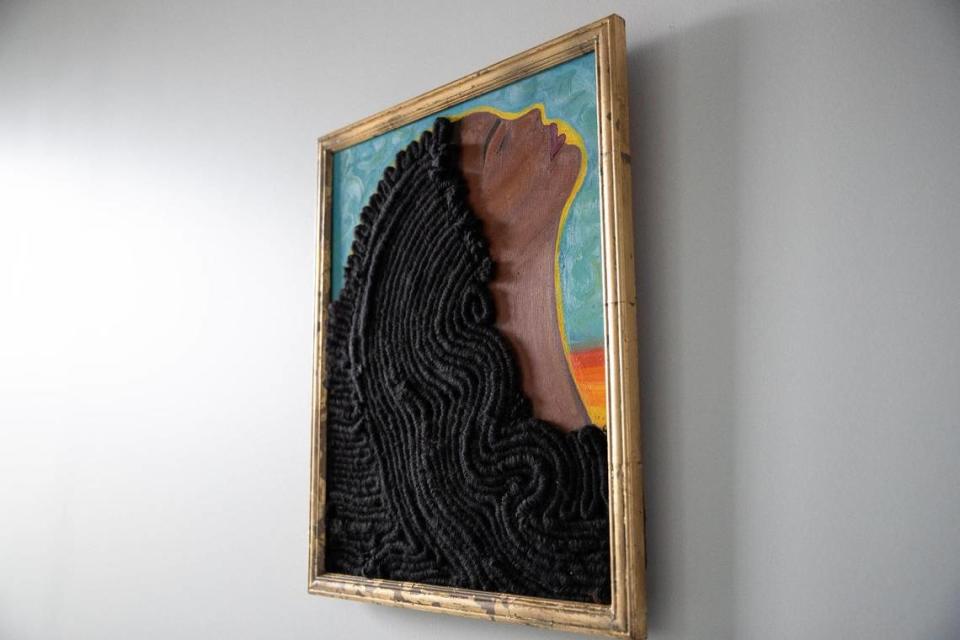
So I think your mind has to change before you know the action of actually doing it. Because, I mean, me cutting my hair and just transitioning and not getting the relaxer anymore. There was a part of me that thought, I am not beautiful or I’m not appealing to anyone. I’m not pretty.
So, I mean, it showed in people’s like attitudes or how they treated me, honestly. So it just got to a point where I was like, You know, I have to do this for myself. It was like it was a great decision that I made for myself because that’s where my self esteem started to build on. Not only that I want to be pretty, but my self-esteem within myself of being confident and just walking out with my hair how it is. And then I started talking to other people about it. They were like I said, it becomes a problem when we are not able to be ourselves in public. So it’s much deeper than just like me wearing a wig, or weave, or some braids, or anything like that.
So yeah, that’s where I think my confidence started. Then after that, you know, I was wearing this hair to cover it up. And then when I started wearing my Afro, that’s when, you know, that’s when the real self confidence had to kick in for me. So that’s when I started saying, okay, I’m out now. They’re looking at me. They’re used to me having this long hair, and I was short, so it definitely was a self-confidence thing that I had to build. Like, years of me training my mind of how society has told us that we’re not beautiful because of these standards.
How did you feel about the responses that you got from the people around you?
Yeah. I mean, I think the people around me, they’re pretty honest. I’m pretty honest too. So them saying this is bad to be like this is it, I don’t know what to tell you. So I mean, I didn’t really take it to heart like that because I felt the same way.
It’s not like I don’t feel comfortable in this at all and so it was like me training my mind to feel comfortable with who I am. That was back in 2010 when it wasn’t as popular. It wasn’t as known as it is now. We’ve come a long way since since then. But we still have like so far to go also.
Were you surprised at all to see you had a lot of camaraderie and other women going through the same thing?
I was very surprised. I knew people were going through that but not to the extent of the self-esteem part. There was some people that I knew that were so confident, but if you were to see they’re real hair they wouldn’t be that person anymore. So I do believe that I was so shocked my that first event that I had with KC Curly. I was so shocked so many people showed up and they felt the same way.
I think I had to step back to look and say, it’s not about hair per se. It’s about us loving ourselves in the way society has put it, especially with Black women, that we are not the muse. We’re not. We’re just the bottom of the totem pole and we’re not the standard of beauty. So I think it was more of a self confidence thing more than anything.
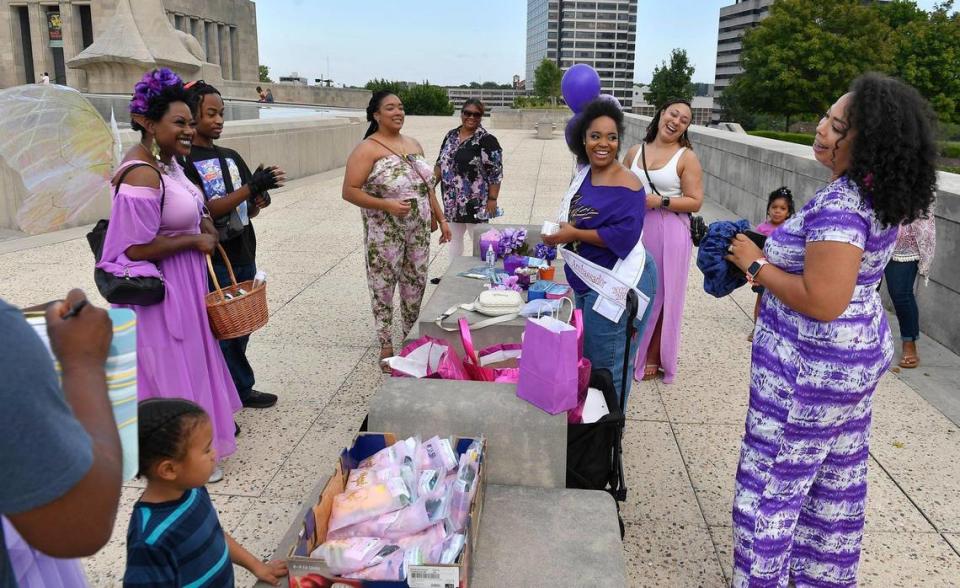
How did you even get the idea to put this together. Why don’t you break it down a bit for people who are not familiar with KC Curly.
Okay. So KC Curly is a huge photo shoot that we put on every single year. So we have a head shots but its just pictures that captured the beauty of just women in their natural light. Just embracing each other. It honestly is like a lift-up-fest. We are lifting each other up.
We are just saying how beautiful each other are. The kids come. We have a rip the runway, like, modeling runway and it’s just confidence building. We have such a good time and then you leave with pictures, you leave with professional pictures.
What’s your favorite part of the event here?
It’s the the kids. They are my favorite. They just light up. If I had that as a kid I would be walking every runway. And so seeing the kids come in and the moms saying, “they didn’t want to come at first with their hair out like this” and then leaving with them saying, “I want to wear my hair like this.”
Every day I see other women, hundreds of women that look just like me. Like part for me wants to cry every single time I get like an email or a DM about their kids confidence and how much this event helps their confidence every year.
How does it feel to be able to become this resource for women in that state?
It feels amazing. Like just for women, for moms to feel confident and their child to feel confident also. So in between the KC Curly event I have probably a couple of mentorships that I do as far as helping moms with their daughters. And then, also, I’m connected with some foster moms that bring in their kids and they don’t know exactly what to do with their hair.
So I just teach them how to manage their hair, simple hairstyles and then also teaching the kid to do those things to help them a little to feel more confident. Honestly, it’s a confidence building mentorship in a sense, but it feels wonderful to just help because you would think it’s just hair, you’re going to be fine, you know?
But this is self-confidence, this is rooted in a child. I feel like when you are seven you kind of root who you are as a person and so the fact that we’re helping people with self-confidence in Kansas City, to me, this is just so wonderful. I just absolutely love it and who would have thought hair would bring all these women together.
This year it rained and it still was hundreds of women. They came by and it was not just a little rain either. It was happening and it was stunning. We were on top of a hill, so they still came and showed out.
So yeah, you guys have been doing it eight years now?
Yes it will be eight years this year.
So you’ve gotten to see a lot of young kids grow up coming to this event. How does it feel to be able to create your own sort of community built around Black hair?
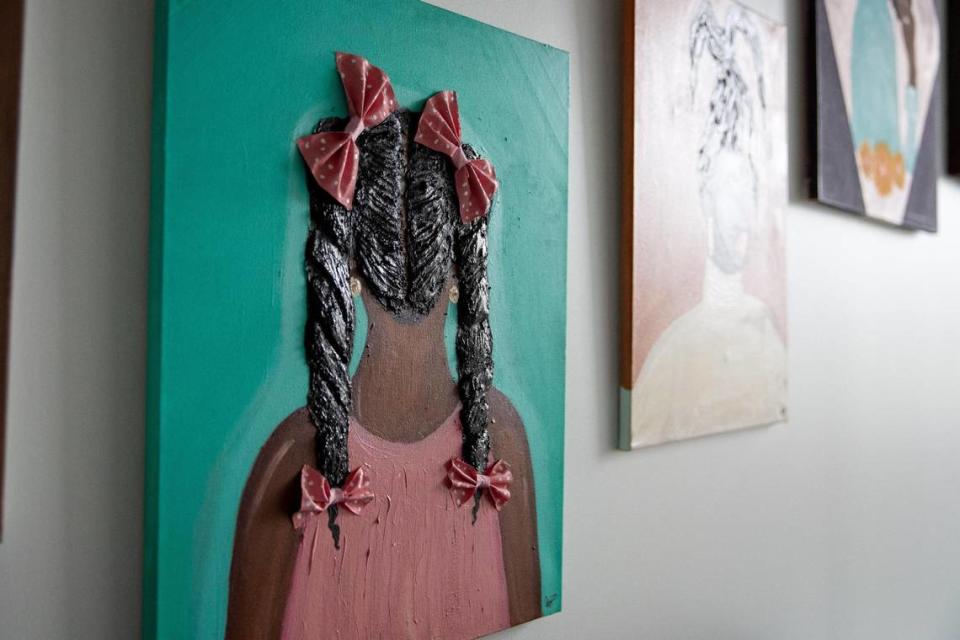
It feels amazing. Like I say it’s deeper than hair but it is so amazing that hair has brought us together. So, I have pictures when kids were a baby and now they’re in kindergarten. So, having those pictures and seeing how much the kids have grown, they have come every single year.
It’s so cool to see the time lapse of the kids and just people in general and how their hair is different each year. But we have a cool community. It’s a very cool, uplifting community that, I don’t really know how to describe it, it is just really cool.
I think that the women, the children, the men that come and the spectators who come, they just watch. They’re just amazed by everything that happens in this short time. It’s putting it all together. Everything is free, so people sponsor it. I’m just amazed by the sponsors and also the photographers because the photographers put in a lot of work that day and it’s a rush.
It is a quick event so you have pictures to last a lifetime. Some people have passed away since. They’ve been so grateful to have pictures from those events and that’s been sad. I love memories, so it’s been amazing, absolutely amazing. Like I said, as long as God has me on this earth I’m here to just celebrate with other people and embrace other people.
What’s been the most difficult part, getting all that off the ground from the first year to now?
I do it by myself so that’s the hard part. People don’t see the full vision of it so they’re like, we need to change the location, put it somewhere else. But I don’t know where to house 400 women either. So I understand that part. But, you know, a lot of things are done by myself.
So all the getting ready for it, putting everything together, I’m doing that all by myself, and I’m okay with that. The photographers, they put in a lot of work. Jill Washington she puts in a lot of work also Alea Lovely, they help every single year.
Then we ask a guest photographer to come in. But even putting all the sponsors together, you don’t know if they’re going to show up that day.
The hardest thing is that it rained this year and it wasn’t going to rain like 30 minutes before it started and so it was like one of those pop up storms. Because usually we would have canceled it and moved it to another day. But that’s been the hardest part of it. Other than that, it gives me so much joy. Honestly, I wouldn’t have it any other way.
I mean, it’d be nice to have someone come alongside it and help us out. But all this stuff is free.
When did you start intertwining hair in art together?
So I will say in 2014 I had this vision about this lady with hidden messages in her hair and I was like this is cool. So, I asked my mom to draw it because my mom is an artist. My whole family are artists and she was like, “Why don’t you try to draw it?”
I was like, well okay, I can try to do it. So I tried to draw it and I showed her. She was like, “oh my gosh, that’s actually good. Keep going.” So, then I painted a picture of something and Mom’s like, “Hey, come to one of my art shows and you want to display it?” I was like, Sure and so I sold it.
I said, you can’t tell me anything. I love this, I love the feeling of this and so I started to use like water bottles and vinyl to bring out the texture in the hair. I started to use yarn, plaster. I was like, let me just play around with this and see what it is.
Because when I go to these museums, I don’t see any Black women at all. Like I don’t see us being a muse or anything. So for me it was like, let me create this vibe and let me bring out the texture in our hair because our hair is full of texture. So that’s where it all started.
How does it feel to be able to open the door for other female artists who may not get the chance to show in the historic Crossroads art District?
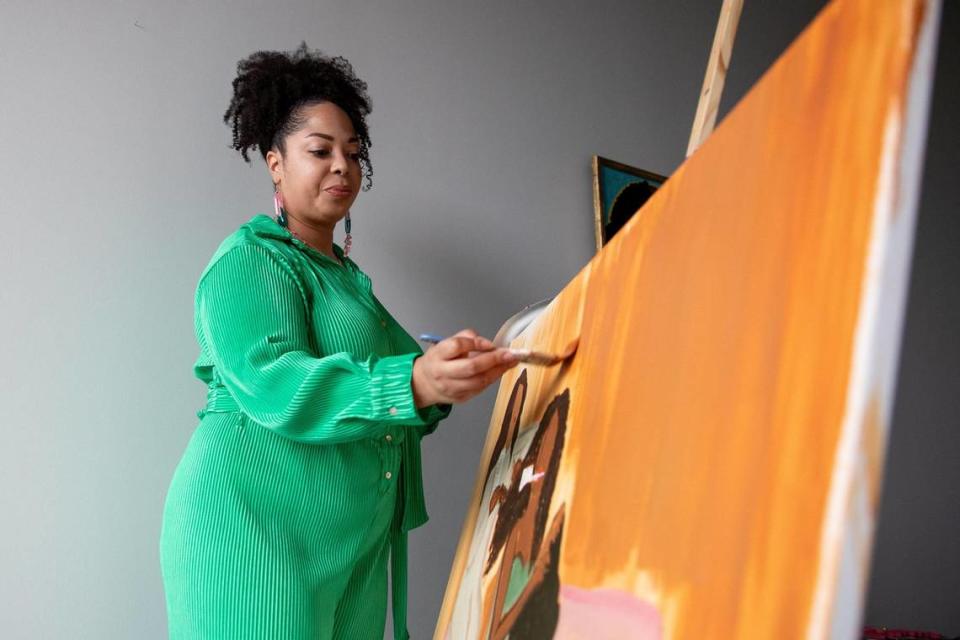
It feels great to open that door because that door wasn’t open for me. I said, You know, since it’s not open for me, I need to create my own environment where it could be open for others.
I absolutely loved it. Then I asked my mom, “Hey, come on, show some art with me.” And then she was like, “I don’t know about that.” And then she ended up coming in. Then I asked my sisters. Then they came in. So it became just this let me just bring some people along. It became a family thing first and then I started bringing other women along.
There’s some men that have come through recently but other women along to show their art in their passion and honestly, I absolutely love putting on these events as you can tell. I just love to put on heavy love to embrace people’s passions and just what they have inside and show that to other people.
Are there any misconceptions that you think people might have about the Black hair struggle?
So many. I think that our whole entity of being a Black woman just in general, there’s just so many connotations. There’s so many negative comments. There’s just so much negativity. When I’m around, I’m spreading the positivity around hair and just how beautiful it is.
Being positive instead of setting a negative light on it. Because people struggle and so teaching people how to manage your hair, looking at it and using different materials to show like, wow, this is really beautiful and so having my art also has opened up the door for a lot of things as far as when it comes to hair. And people look at it differently.
People of different races come and they see my art in there and they’re just looking at it for a while, just trying to figure out what, what, material is this?
Honestly, I’m like, hey, if you’re looking at it more than like two seconds, I got your attention, you know? So yeah.
How does it feel to be the kind of pioneer of the Black hair photo shoot here in Kansas City?
I love it. I absolutely love it because honestly, it’s just embracing more people to be themselves at the end of the day and so people have ideas as far as photo shoots or anything like that. I mean, at the end of the day, it is making everyone feel confident and beautiful with who they are. So I absolutely love it.
What’s next for Crissi, Curly, KC Curly and the Crossroads art shows?
Well, we got to keep on track and keep going. We’re going to keep adding different elements to KC Curly and adding different sponsors. We have different sponsors this year and so working on some things to kind of just make it a little bit different. So,I’m excited for the the people, the kids that come out.
As far as the Crossroads, we are working with them this year to see exactly what we’re going to do next as far as location and everything like that. So yeah, we’re just going to keep moving along and kind of go with the flow of things and just keep embracing people and making them happy.
Excellent. And why don’t you tell the people how they can get involved and stay up to date? What’s going on with KC Curly?
You can go to kccurly.com. You can also go to our Instagram page, KC Curly, and then also our Facebook page, KC Curly Everything is KC Curly. We’ll have some updates coming up this year and so you can follow all that on their.

